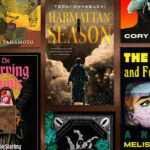
How To Raise a Reader in an Age of Digital Distraction
Jessica Ewing on the Ways Parents Can Promote Thoughtful Technology Use and Sustainable Reading Habits
People make certain assumptions about you when you’re the CEO of a children’s book company. Some assume I must have spent my childhood summers in a hammock reading Rebecca of Sunnybrook Farm, or winters taking turns reading Little Women by the fire with my sisters. The reality is far more complicated, quite a bit less wholesome, and probably more familiar to most parents reading this.
The truth is I spent a good chunk of my childhood rotating between three game consoles—a Sega Genesis, a Gameboy, and a multitude of PC games, some featuring nudity and/or violence. During the school year, I had the entire TGIF television lineup memorized (and still do). My idea of a middle grade novel was Carrie, which I conveniently “borrowed” from my brother’s vast Stephen King collection.
That isn’t to say I didn’t grow up with books and even age-appropriate ones—just that I don’t recall my parents being particularly concerned about screen time. There was no cultural panic about technology rotting my brain. We weren’t unusual in this regard. Screens were alive and well in my childhood, just as they are today.
The real challenge isn’t technology itself, but how technology has evolved to actively compete with the very cognitive processes that reading requires.
The difference wasn’t the presence of technology in our lives; it was the nature of our relationship with it.
When I fired up Kings Quest VI, I committed. I guided Alexander through the Land of Green Isles, memorized the magic map, and worked my ass off to solve the puzzles at the Cliffs of Logic. The game didn’t ping me with notifications every few minutes. It didn’t track my behavior to sell me anything. It didn’t fragment my attention into bite-sized dopamine hits designed by teams of psychologists to maximize engagement. It was, in its own way, long-form content that demanded sustained focus—not so different from the mental muscles required for reading.
This distinction matters more than we might think, especially for those of us trying to raise readers in 2025. It’s easy to blame screens wholesale for declining literacy rates, but I find that both reductive and unhelpful. The real challenge isn’t technology itself, but how technology has evolved to actively compete with the very cognitive processes that reading requires.
The Unnatural Act of Reading
Here’s something that might surprise you: reading isn’t natural. Unlike speaking, which humans develop organically, reading is an acquired skill that literally rewires the brain. Neuroscientist Maryanne Wolf, whose research has fundamentally shaped my understanding of how children develop as readers, describes reading as “an unnatural act” that requires us to connect disparate neural pathways in ways evolution never intended.
Wolf’s work reveals something remarkable about the reading brain. When we read, we’re essentially performing a complex neural symphony. Our brains must coordinate visual processing, language comprehension, memory systems, and abstract thinking—all in milliseconds. This isn’t something that happens automatically. It’s built through practice, repetition, and what Wolf calls “deep reading circuits.”
Children who become strong readers develop these circuits through thousands of hours of focused attention on text. Their brains learn to process written language with increasing fluency until the act becomes as natural as breathing. But here’s the crucial part: these circuits are fragile, especially in the early years. They require sustained, focused attention to develop properly.
This is where our modern digital landscape becomes genuinely problematic. Not because screens are inherently evil, but because many of today’s digital experiences are specifically designed to prevent such sustained attention.
When Screens Turned Predatory
The screens of my childhood were fundamentally different than what our children encounter today. When I played Where In The World Is Carmen Sandiego, the game wanted me to stay engaged, certainly, but it didn’t have access to sophisticated behavioral data about what kept me playing. It couldn’t A/B test different reward schedules or generate feedback loops from my friends with every action I took. Carmen didn’t appear suddenly with a sponsored post that preyed on my insecurities and tried to sell me teeth whitening gel.
Today’s digital experiences are built on what tech insiders call “persuasive design”—interfaces deliberately crafted to maximize time on screen through intermittent variable rewards, social validation loops, and carefully calibrated frustration. These aren’t accidents. They’re the result of millions of dollars in research into human psychology and memory, designed specifically to capture (and fragment) attention.
The average child now receives their first smartphone around age 10 and spends over seven hours a day on screens. But far more troubling than the raw hours is how this time is spent: in short bursts, rapidly switching between apps, constantly responding to notifications and alerts.
This creates what researchers call “continuous partial attention”—a state where we’re always monitoring multiple streams of information but never fully focused on any single task. It’s the cognitive equivalent of trying to build muscles by switching between machines every few seconds before we can get in a single quality set.
And yet, here’s what gives me hope in the data: not all children are struggling. While average reading scores have indeed declined, the top-performing readers are actually doing better than ever before. This suggests that the challenge isn’t insurmountable—some families and schools are successfully navigating this landscape. The question is: what are they doing differently?
Building Participation
Running a children’s book company has given me a front-row seat to what actually works in developing young readers. Over the past decade, we’ve been exposed to a multitude of stories on what is working—and what isn’t—that informs our own product design.
The children who thrive as readers share two key characteristics: they’re actively engaged with their reading from the earliest ages, and reading has been ritualized as a cherished family habit.
Active engagement is crucial. This doesn’t mean turning every book into an interactive multimedia experience. Rather, it means ensuring that children are mentally participating in the reading process rather than passively consuming. With toddlers, this might mean encouraging them to point to pictures, make sound effects, or predict what comes next. With older children, it involves asking questions that go beyond basic comprehension: “What do you think motivates this character?” “How would the story change if it were set in our neighborhood?”
We’ve discovered that children who regularly engage in these kinds of active reading practices develop stronger neural pathways for deep comprehension. Their brains learn to treat reading as an interactive, creative process rather than a passive reception of information.
The ritualization piece is equally important. The families raising strong readers don’t just find time for books—they create sacred space around reading. This might mean a bedtime routine that’s never rushed, weekend morning reading sessions with special snacks, or car trips where audiobooks replace music. The key is consistency and intentionality.
One mother told me that she and her seven-year-old have “reading dates” every Saturday morning at their local coffee shop. They each bring a book, order hot chocolate, and read silently together for an hour. Her daughter now looks forward to these sessions more than screen time. This isn’t magic—it’s the power of positive association and ritual.
But perhaps our most important discovery is this: the parents raising successful readers aren’t necessarily limiting screen time more than other families. Instead, they’re being strategic about what kind of screen experiences they’re choosing.
Science as Our Antidote to Technology
Wolf’s research points us toward a solution that’s both practical and hopeful. If reading circuits are built through focused attention and practice, then our job as parents isn’t to eliminate technology—it’s to create intentional spaces where deep attention can flourish.
This means being ruthlessly selective about digital experiences. Not all screen time is created equal. A child watching a thoughtfully crafted film[?] or playing a strategy game that requires sustained focus is having a fundamentally different cognitive experience than one rapidly scrolling through short-form videos.
The neuroscience suggests several practical strategies. First, protect the early morning and pre-bedtime hours as screen-free zones. These are when our brains are most receptive to the kind of focused processing that reading requires. Second, create physical spaces in your home that are associated exclusively with reading—no devices allowed.
Third, and perhaps most importantly, model the behavior you want to see. Children are remarkably adept at detecting when adults are partially present, their attention split between conversation and the notification pings in their pockets. If we want our children to develop the capacity for sustained attention, we must demonstrate it ourselves.
Our job as parents isn’t to eliminate technology—it’s to create intentional spaces where deep attention can flourish.
I think about my own childhood, rotating between those game consoles and books, often within the same afternoon. The difference wasn’t that my parents were anti-technology. It’s that the technology of that era didn’t actively compete with my ability to concentrate. Today’s parents face a more challenging landscape, but they also have something we didn’t: a growing understanding of how attention works and how to protect it.
The Path Forward
The children who are thriving as readers in 2025 aren’t growing up in some idealized, screen-free bubble. They’re learning to navigate a complex media landscape with intention and purpose. Their parents understand that the goal isn’t to return to some imagined golden age of childhood, but to apply what we now know about brain development to create a new (and equally beautiful) childhood where deep reading can flourish alongside thoughtful technology use.
This requires us to move beyond the false choice between books and screens toward a more nuanced understanding of attention, engagement, and cognitive development. It means teaching our children—and ourselves—that not all digital experiences are equivalent, and that the most important skill we can develop in an age of distraction might be the ability to choose what deserves our focused attention.
The stakes feel particularly high because we’re not just raising readers—we’re raising citizens who will need to think critically, process complex information, and maintain focus in an increasingly chaotic world. The neural pathways that Wolf describes, those deep reading circuits built through sustained attention to text, are the same ones that enable complex reasoning, empathy, and the kind of patient thinking that democracy requires.
But here’s what I find most encouraging: the human brain remains remarkably plastic, especially in childhood. Every day presents new opportunities to build these crucial circuits. Every bedtime story, every conversation about a book, every moment of focused attention is rewiring our children’s minds for the better.
The hammock and Rebecca of Sunnybrook Farm were never really the point. The point was always the quality of attention we bring to whatever we’re reading, and our willingness to create space for the kind of deep thinking that transforms both individuals and societies. That’s as possible today as it ever was—we just need to be more intentional about how we get there.
Jessica Ewing
Jessica Ewing is the Founder & CEO of Literati, a education technology company reaching over 1.5 million kids annually through school book fairs, e-commerce and subscription services. Literati’s mission is to “ignite a love of learning and a love of life” and accomplishes that by leveraging human and machine intelligence to help kids, parents and educators find the perfect books for the school library, classroom and home. Literati’s platform has successfully raised $26M for schools to date, and has delivered 17 million new books in the hands of kids. Jess is a graduate of Stanford University, where she studied computer science and mathematics, and was a nationally ranked collegiate debater. She later joined Google, where she worked for five years developing consumer products in personalization and was featured in Fast Company as one of “Google’s 12 Most Innovative Minds.” She is the co-owner of five different patents in consumer technology design. Jess lives in Austin, TX with her husband Tom and golden retriever Campbell, named after the writer and mythologist Joseph Campbell.



















